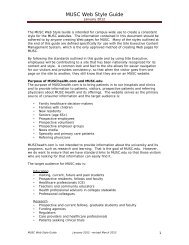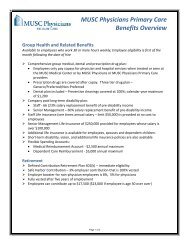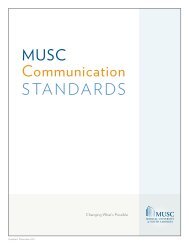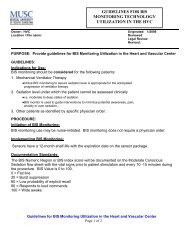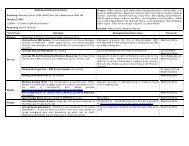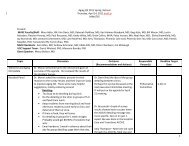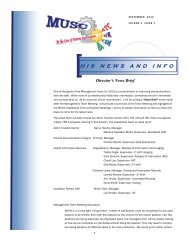"Medication Interventions for Fall Prevention in the Older Adult." J
"Medication Interventions for Fall Prevention in the Older Adult." J
"Medication Interventions for Fall Prevention in the Older Adult." J
You also want an ePaper? Increase the reach of your titles
YUMPU automatically turns print PDFs into web optimized ePapers that Google loves.
Reviews <strong>Fall</strong> prevention <strong>in</strong> older adultscosts 18–20 are also important means of fall prevention. In onestudy, buspirone <strong>in</strong>tervention <strong>in</strong> place of BZs and/or antipsychotics,careful drug withdrawal by stepwise discont<strong>in</strong>uancewith taper<strong>in</strong>g of 10% to 25% of <strong>the</strong> dose per week, or both alsohave been shown to decrease falls by 70% and improve cognitioncompared with similar patients. 17 The provisions of <strong>the</strong>Omnibus Budget Reconciliation Acts of 1987 and 1990 on appropriateuse of psychotropic drugs <strong>in</strong> <strong>the</strong> United States mandateat least two to three taper<strong>in</strong>g attempts of anxiolytics andantipsychotic psychotropics with<strong>in</strong> <strong>the</strong> first 6 to 12 months ofplacement with<strong>in</strong> a nurs<strong>in</strong>g facility. Effective October 1, 2008,Medicare no longer reimburses <strong>for</strong> falls occurr<strong>in</strong>g <strong>in</strong> acute caresett<strong>in</strong>gs, as a “hospital-acquired condition.” 21 The newest Centers<strong>for</strong> Medicare & Medicaid Services (CMS) guidel<strong>in</strong>es stress<strong>the</strong> need <strong>for</strong> gradual reduction of all psychotropic medicationdoses, <strong>in</strong>clud<strong>in</strong>g buspirone, unless patient dementia or o<strong>the</strong>rneuropsychiatric illness worsens dur<strong>in</strong>g attempts at taper<strong>in</strong>g.Examples of <strong>the</strong> concept of adverse effects on rapid or suddenversus gradual drug withdrawal <strong>in</strong>clude seizures with BZs, tardivedysk<strong>in</strong>esia or return of schizophrenia signs and symptomswith antipsychotics, and seroton<strong>in</strong> syndrome and worsen<strong>in</strong>g ofdepression with rapid withdrawal of antidepressants. See www.cms.hhs.gov <strong>for</strong> <strong>the</strong> latest CMS guidel<strong>in</strong>es <strong>for</strong> medications.A meta-analysis of 57 studies on <strong>the</strong> contribution of psychotropicdrugs to falls <strong>in</strong> older patients concluded that a small butconsistent association exists between <strong>the</strong> use of most classesof drugs and falls. The meta-analysis did not consider or def<strong>in</strong>e<strong>in</strong>appropriate polypharmacy. 22 <strong>Fall</strong>s were second only to nonsteroidalanti-<strong>in</strong>flammatory drug (NSAID) adverse drug reactionsas causes <strong>for</strong> adverse drug reaction hospitalizations from<strong>the</strong> long-term care facility. 23 A 1966–1999 review of psychotropicsand falls suggested that all psychotropics may <strong>in</strong>crease <strong>the</strong>risk of falls and that each additional agent may <strong>in</strong>crease <strong>the</strong>overall risk by a factor of 2.0 per psychotropic. 24 A communitybased6-month study of 305 male veterans (age 70–104 years)us<strong>in</strong>g psychoactive CNS-active medications were screenedat study entry <strong>for</strong> mobility, cognition, and depression. CNSactivemedications were categorized as BZs, o<strong>the</strong>r sedative–hypnotics, neuroleptics, tricyclic antidepressants, and opioidanalgesics. Patients were prospectively followed <strong>for</strong> 6 monthsto monitor falls; at <strong>the</strong> end of this time period, patients wereclassified as fallers (at least one fall) or nonfallers. The relationshipbetween CNS-active drug use and falls was exam<strong>in</strong>edus<strong>in</strong>g multivariable analyses. The risk of falls was significantlygreater <strong>in</strong> CNS-active medication users compared with nonusers.Adjusted odds ratio (OR) was 1.54 (95% CI 1.07–2.22)<strong>for</strong> one CNS-active drug and 2.37 (1.14–4.94) <strong>for</strong> two or moreagents. In community-dwell<strong>in</strong>g elderly, use of multiple CNS-activemedications is associated with enhanced fall liability comparedwith use of one CNS-active drug. 25Inappropriate polypharmacy and multiplepsychoactive drugsMultiple psychotropic and psychoactive drugs should betaken <strong>in</strong>to account when fall <strong>in</strong>terventions are evaluated, andreduction <strong>in</strong> total psychotropic and psychoactive drug load mayreduce fall occurrence and recurrence. 26–28 Simply put, eachadditional psychotropic doubled <strong>the</strong> rate of falls, as suggestedby an earlier review 24 and research. 26–28 An earlier study <strong>in</strong> thispopulation <strong>in</strong>dicated that those who had psychotropic drugs tapered,changed to o<strong>the</strong>r agents, and/or discont<strong>in</strong>ued had fewerfalls and <strong>in</strong>juries and less cognitive decl<strong>in</strong>e over 1 year. 17 A differencewas observed <strong>in</strong> <strong>the</strong> mean Reisberg global deteriorationscale 29 <strong>in</strong> those with a diagnosis of dementia between usersof psychotropic drugs (5.8 on 7-po<strong>in</strong>t scale) and those taperedto nonuse of psychotropic drugs (4.7) <strong>in</strong> <strong>the</strong> groups at <strong>the</strong> beg<strong>in</strong>n<strong>in</strong>gof <strong>the</strong> study. 17The most recent f<strong>in</strong>d<strong>in</strong>g is that all causes of hospitalizationof <strong>the</strong> older adult from long-term care are directly proportionalto <strong>the</strong> total psychoactive drug load. 28 The recent black boxwarn<strong>in</strong>g relabel<strong>in</strong>g of all antipsychotics states that this classof medications should not be used <strong>for</strong> long periods <strong>in</strong> patientswith dementia because of greater risk of death—more evidencethat <strong>the</strong>se drugs have high risk <strong>for</strong> <strong>the</strong> older adult. Pharmacistsshould review <strong>the</strong>se black box warn<strong>in</strong>gs on antipsychotic package<strong>in</strong>serts and patient education materials or at <strong>the</strong> Food andDrug Adm<strong>in</strong>istration drug safety website (www.fda.gov/medwatch/safety).Anemia and vitam<strong>in</strong> D deficiency and fallsIn community-dwell<strong>in</strong>g elderly, anemia is associated witha number of health-related functional decl<strong>in</strong>es, such as frailty,disability, and muscle weakness. These may contribute to falls,which, <strong>in</strong> <strong>the</strong> elderly, result <strong>in</strong> serious <strong>in</strong>juries <strong>in</strong> perhaps 10%of cases. Whe<strong>the</strong>r anemia <strong>in</strong>creased <strong>the</strong> risk of <strong>in</strong>jurious falls <strong>in</strong>an elderly population was <strong>in</strong>vestigated us<strong>in</strong>g health <strong>in</strong>suranceclaims and laboratory test results data from January 1999 toApril 2004 <strong>for</strong> 47,530 <strong>in</strong>dividuals 65 years of age or older enrolled<strong>in</strong> more than 30 managed care plans. 45Anemia <strong>in</strong> nurs<strong>in</strong>g home residents appears to be underrecognized.For residents older than 70 years, <strong>the</strong> prevalence ofanemia <strong>in</strong> one study <strong>for</strong> both men (Hb





